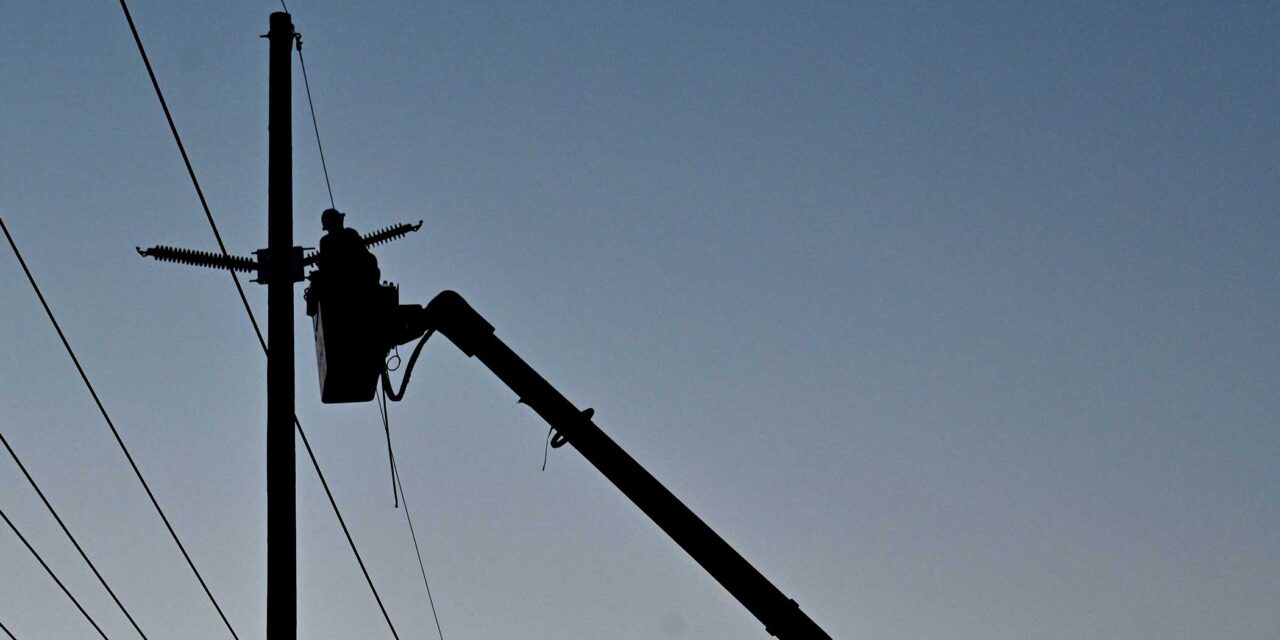Agencies Rally to Restore Normalcy
by Linda L. Esterson
The Calm After the Storm
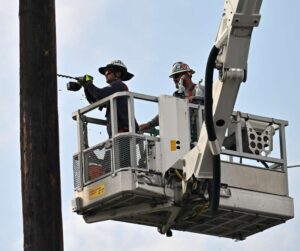
BGE workers pole “frame” (attach and install new transformers, fuses, conductors, and other various electric equipment required for the new poles to safely and reliably deliver power). Photos supplied by Dylan Slagle, BGE
It started out like any other Monday afternoon. On August 7, 2023 Milt Beebe was on his way to pick up carryout. Mother Nature, however, had a different plan.
One of the worst storms in recent memory hit Carroll County. Winds gusted up to 80 mph and heavy rains fell across the area. Although the storm passed in just 30 minutes, according to National Weather Service reports, it left a lot of damage in its wake.
Beebe was stopped before the light at Route 140 and Malcolm Drive in Westminster. High-voltage utility poles, which stood 85 feet tall, waved back and forth “like a blade of grass” and then crashed to the ground. A pole landed in front of his vehicle and the attached wires collapsed on top of his car with great force, cutting through the roof. His windshield and back window were shattered, and water gushed into the car. Beebe watched as the line of poles fell “like dominos.”
A former military member and electrical engineer, Beebe remained calm. “I knew the worst was over. I knew that I was going to be saved. It was just a matter of time,” he says. “I told myself to relax, that I couldn’t do anything.”
As advised by emergency personnel, Beebe waited in his car, periodically napping.
 Also stopped at the intersection was Officer Ted Buck, then a member of the criminal enforcement division of the Maryland State Police. Buck recalls a howling wind, a suddenly “pitch-black sky” and rain pouring “almost sideways.” Then the poles fell.
Also stopped at the intersection was Officer Ted Buck, then a member of the criminal enforcement division of the Maryland State Police. Buck recalls a howling wind, a suddenly “pitch-black sky” and rain pouring “almost sideways.” Then the poles fell.
His vehicle also endured the crash-landing of the powerlines, which melted plastic and dented metal. Two of his children were in the backseat, and although scared, they remained calm.
Just as quickly as the storm rolled in, it was gone and the sun peered through the sky.
“I don’t think there was any way to prepare for it,” Buck says. “I don’t recall ever hearing a wind sound like that. As soon as I heard the howling, I thought to myself that we were about to go through a tornado.”
All Hands on Deck

The damage caused by the storm in the immediate hours following. Photos by Kevin Dayhoff, Westminster Fire Department
The first call came into the Carroll County Emergency Communications Center (911 Center) at 3:45 p.m. for a vehicle collision at Routes 97 and 140. Emergency responders soon learned it was more complicated than that. Twenty-one electric transmission poles were broken off and laying in the eastbound lane of 140 between Gorsuch Road and Market Street, a stretch that spanned 4,700 feet — just less than a mile — according to Jamie Barnett, BGE’s director of transmission and substation. Thirty adults and 14 children were instructed by officials to remain in the 34 affected cars. No injuries were reported.
“We have never seen anything like what happened on Route 140,” says Valerie Hawkins, director of public safety for Carroll County. “We have never had a situation where we had multiple utility poles of that type go down all at once, and definitely not on one of the largest arteries for traffic in the county.”
The county’s Emergency Operations Center was activated and served as the coordinating base for all emergency responders from the Carroll County Fire Department and volunteer fire companies, Carroll County Sheriff’s Office, Maryland State Police, Westminster Police Department, BGE, Maryland State Highway Administration, and Department of Public Works. A mobile operations center was set up at the 140 Village Shopping Center, close to the scene for the police, fire department and BGE for coordinated assessment, planning, safety and management discussions.
“When you get to a certain point in some of these larger incidents, you really need to have another mechanism to coordinate all of that activity across the county to try to make the response be as efficient and effective as we can possibly make it,” Hawkins explains. “We don’t want people working in silos. We’re trying to encourage communication across all those discipline lines to have the most effective response that we can.”
Fostering Relationships
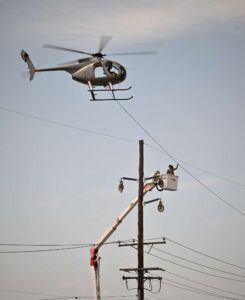
The helicopter pulled a “lead line” a lightweight rope through attachments on newly installed poles. Photo supplied by Dylan Slagle, BGE
The 911 Center fielded hundreds of calls from motorists in the wreckage and others from all over the county. From 5-6 p.m. alone, Hawkins says, the center received more than 400 calls. According to Carroll County Fire Chief Michael Robinson, about 500 emergency personnel were involved that evening.
Much time is spent on emergency preparedness. Agencies have emergency plans, and a county-wide Emergency Operations Plan incorporates roles from the different entities. Agency personnel participate in many cross-trainings in preparation for collaborative responses to emergencies.
“We build the relationships and know which agencies have which capabilities and then make sure that … the other agencies that are involved know each other, so we’re building a whole network of communication and collaboration. When something like this does happen, we all already know each other and we all know our basic capabilities,” Hawkins says.
County officials worked to get the resources needed to clean up the scene, free those trapped in their vehicles, restore power to the area and return the county to its normal operations. What was initially projected to take 2½ weeks was completed in just one week.
“It was the entire community coming together, all of the different agencies, the system that’s in place from the time you call 911 to the time police, fire and EMS respond and all the way through the process,” Hawkins notes.
A Tall Task
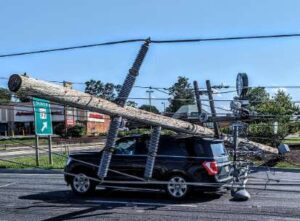
The damage caused by the storm in the immediate hours following. Photos by Kevin Dayhoff, Westminster Fire Department
With potential injuries, rescues, and electrical issues with the powerlines down, the event necessitated a “mutual aid response.” Police and fire department personnel ensured motorists remained in their cars while damage and safety were assessed, and the road was closed and traffic detours were arranged.
During the storm’s peak, the traffic light was red on Route 140 at Malcolm Drive. More damage would have occurred if the cars were moving, says Barnett.
The first priority for utility leaders was to ensure the wires were no longer live. When fully energized, the poles carry nearly 175,000 volts in total through all lines. Once BGE’s emergency control center verified the power was fully removed, some five to six hours later, emergency services personnel began assisting the stranded motorists. Many of the cars remained in the intersection overnight until the wires, which were still taut, could be removed.
“It can be a tremendously hazardous event,” Barnett acknowledges. For one thing, some of the transformers on the utility poles contained oil and needed to be disposed of safely.
With crews working into the night to secure the site, cleanup did not begin until early the next morning. In addition to removing wires, broken poles and other debris, the stumps that remained in the ground were cut down below grade and covered with dirt. At the same time, planning was underway to secure replacement poles and wires and the specialty equipment needed to create 9-foot-deep holes to house the new poles.
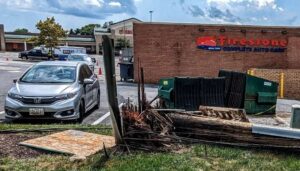
The force of the storm snapped the utility poles.
Photo supplied by Kevin Dayhoff, Westminster Fire Department
Each step of the process was meticulously planned by designated teams that considered several options before moving forward, albeit quickly, Barnett notes. The planning also involved contacting other utility companies and contractors to support the effort. Some were local to Maryland while others traveled from across the United States.
By Day Three, the new poles were in the ground, and work was underway to install cross arms and framing devices for the wires. BGE contracted a helicopter company to pull the wires from pole to pole, and the task was completed in a half-day.
On the seventh day, the last circuit was energized. Power was restored to the community and the street was reopened. In total, several thousand workers and contractors, from all of the participating agencies and affiliated companies, had played a role in returning Westminster to normal.
“This was an all-hands event,” Barnett says. “We raised the storm flag as high as it goes for us … When we arrived on site, I recognized that this was one-of-a-kind, that this was something we haven’t seen and hopefully won’t see again in the future.”
Other Areas in Need
While the relief effort on 140 was a primary focus, other crews worked to restore power to affected customers throughout the county. Substations were switched, mobile trailers arrived and cabling was rerouted to energize circuits. According to Barnett, service was returned to most county customers within two days of the storm.
In addition, a variety of secondary issues also taxed emergency responders. According to Chief Robinson, during the three-hour period after the storm, there were over 200 emergency response calls. There were vehicle collisions, trees down on cars and in roadways, a building collapse in Lineboro, and a propane tank rupture from a fallen tree branch in Manchester. An individual walked into the Hampstead fire station with a tree branch lodged in their arm.
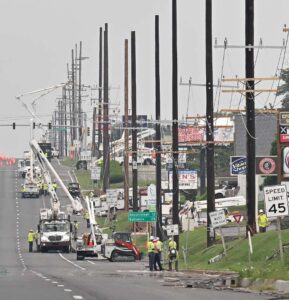
BGE workers assess the damage and prepare to repair or rebuild the poles. Photo supplied by Dylan Slagle, BGE
Also credited in the effort are the many other jurisdictions that served as “mutual aid partners.” Units from Baltimore County, Frederick County, Howard County, and Adams and York counties in Pennsylvania responded to incidents and covered the county fire stations for local needs.
Mutual aid coverage is provided through the National Incident Management System (NIMS), used by police and fire departments and utility companies across the country to ensure consistency of response. It also deploys additional personnel to provide assistance. Several Carroll County Fire Department employees were deployed to the recent Hawaii wildfires through the system, Robinson says.
“We’re all partners in this, whether it’s state police, sheriff’s department, municipal police, fire and EMS. We cover the whole county,” Robinson notes. “We plan a lot. When things happen, they’re seamless.”
Help also was provided in other ways. Westminster City Council member Kevin Dayhoff, who serves as the Carroll County Fire Department’s public information officer, arranged the donation of Chick-fil-A sandwiches and water bottles to the trapped motorists. After losing power, Target leadership donated $11,000 in fresh and frozen food to Carroll County Food Sunday. The food was provided to pantry clients and shared with other pantries, says Caroline Babylon, executive director.
Finally Free
At 10:30 p.m., the remaining motorists were permitted to leave their vehicles. Some were transported to Winters Mill High School to await pickup by family members. Beebe walked across the street to the Dunkin’ parking lot to meet a neighbor. The cars were transported to a shopping center lot and guarded by Sheriff’s Department officers around the clock until being claimed a few days later.
“I don’t think we could have done anything better,” notes Lt. Rebecca Bosley, Westminster barracks commander for the Maryland State Police. “It highlighted how well we work as a county, together, to get things done in a fast, safe manner.”
Months removed from the ordeal, Beebe acknowledges he still misses Elijah, his one-of-a-kind Elantra. His “new” 2016 Buick, however, runs fine.
“It is what it is; I can’t change that,” he says. “I’m thankful I’m alive.”

